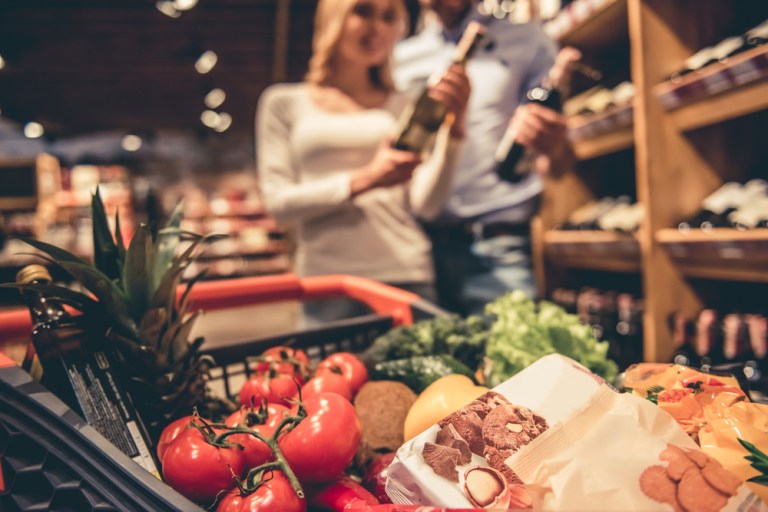
American dining habits are changing, and so is how consumers spend money on food. Millennials and younger portions of the population are now turning to convenient, customizable and healthy fare in search of sustenance that fits into their daily hustles.
Rather than gathering around the dinner table for a home-cooked meal that could take hours to prep, many are turning to meal kits and takeout. That’s creating new competition for grocery stores, which provide the raw ingredients needed to cook at-home meals, and is good news for quick-service restaurants (QSRs), delivery services and other companies offering the easy-to-make, nutritious meals consumers crave.
The amount consumers spend at restaurants is increasing, according to research from First Data’s “Quarterly SpendTrend Report: Q2 2018,” and the amount they spend at grocery stores is decreasing. Grocery store and restaurant spend was split nearly down the middle in the first half of 2017, with 49 percent of spending directed to grocery store registers and restaurants accounting for the other 51 percent.
The split has since only grown wider, however. Restaurants widened the gap over grocery stores in the H2 2017, accounting for 53 percent of spending by H1 2018.
Grocery Growth Lags
Restaurants have been able to capture an ever-larger percentage of consumer food spend, largely due to growth in restaurant expenditures. Restaurant spending topped that of grocery stores in both Q1 and Q2 2018, increasing 3.6 percent in Q2 compared to 1.7 percent for grocery stores.
The rise in QSR sales underpins the growing influence and popularity of mobile order-ahead capabilities. Recent reports indicate that more consumers are picking up their smartphones to order food, with nearly 40 percent telling researchers earlier this year that they had placed an order using their smartphones within the past 90 days.
That may not be representative of the American majority quite yet, but the number is climbing quickly. Just 11 percent reported using mobile order-ahead offerings in 2015, marking an almost 400 percent increase in user adoption over those three years. All told, QSRs accounted for 38 percent of restaurant spending in Q2 2018 and saw more than 7 percent year-over-year growth, the largest share among restaurant categories.
Growing Ticket Sizes
Restaurants have been able to capture an ever-larger percentage of consumer food spend – thanks, in large part, to growth in restaurant expenditures. Restaurant spending topped that of grocery stores in both Q1 and Q2 2018, increasing 3.6 percent in Q2 compared to 1.7 percent for grocery stores.
Restaurants showed some growth of their own, but didn’t quite match the pace of grocers. Ticket sizes grew by at least 1 percent in each quarter dating back to Q2 2017, but never quite reached the highs grocers saw, topping out at 1.9 percent growth in Q1 2018.
The Future of U.S. Food
Restaurants may see ticket sizes rise even further, too, as many owners and app developers report receiving higher average ticket prices when orders come from mobile apps. Michael Chachula, executive director and head of IT at IHOP, told PYMNTS earlier this year that the breakfast chain has seen an uptick in both order total size and price. He believes those shifts are motivated by a change in value propositions for customers.
“When you’re sitting at the table and grab the menu, you can just ask your server to bring you something extra,” Chachula said. “But, if you’re at home and then remember that [something extra], you’re not going to take off your pajamas to pick up more food. So, what people tend to do is say, ‘I know I might want this,’ or ‘I think I might want this,’ and they place a larger order — even if they end up saving food for leftovers the next day.”
Grocery stores are also seeing a shift, as more consumers now shop for groceries and food online. According to research released earlier this year, while connected offerings may not have caught on among all consumers, young customers and millennials are increasingly using them.
Some of the largest players in the space have begun improving their offerings by rolling out delivery and curbside pickup services, along with better payment options, richer loyalty rewards and more. These improvements will put grocery merchants in a good position to keep up with the competition.
As more consumers embrace the appeal of online offerings, a growing share of grocery and restaurant sales will be made via connected channels.
About the Playbook
The PYMNTS Commerce Connected series, in partnership with First Data, is designed to give readers an overview of the latest developments, data and trends from around the connected commerce space. Each issue of the Playbook covers the major news and trends from connected commerce players and includes a data-driven Deep Dive into various retail segments and industries.